Manuscript accepted on : 22 October 2011
Published online on: 28-12-2011
Synthesis of Biosuperabsorbent Based on Carboxymethylcellulose-g-poly(AcA-co-AN)
Mohammad Sadeghi*, Nahid Ghasemi¹ and Mojgan Yarahmadi²
¹Department of Chemistry, Science Faculty, Islamic Azad University, Arak Branch, Arak Iran.
²Department of English, Faculty of Humanities, Arak Branch, Islamic Azad University, Arak Iran.
Corresponding Author E-mail: m-sadeghi@iau-arak.ac.ir
ABSTRACT: Biosuperabsorbent polymers are obtained by the graft copolymerization of acrylic acid (AcA) and acrylonitrile(AN) monomers onto CMC, using Ceric ammonium nitrate as a free radical initiator in the presence of methylene bisacrylamide as a crosslinker. Infrared spectroscopy and TGA thermal analysis were carried out to confirm the chemical structure of the hydrogel. Moreover, morphology of the samples was examined by scanning electron microscopy (SEM). Final, The swelling kinetics of the synthesized hydrogels with various particle sizes was also preliminarily investigated.
KEYWORDS: CMC; Hydrogel; Swelling; Acrylic acid; Acrylonitrile
Download this article as:| Copy the following to cite this article: Sadeghi M, Ghasemi N, Yarahmadi M. Synthesis of Biosuperabsorbent Based on Carboxymethylcellulose-g-poly(AcA-co-AN). Biosci Biotech Res Asia 2011;8(2) |
| Copy the following to cite this URL: Sadeghi M, Ghasemi N, Yarahmadi M. Synthesis of Biosuperabsorbent Based on Carboxymethylcellulose-g-poly(AcA-co-AN). Biosci Biotech Res Asia 2011;8(2). Available from: https://www.biotech-asia.org/?p=9264/ |
Introduction
The market for superabsorbent polymers (SAPs) has increased by a factor of 5 over the past 10 years. These materials are crosslinked hydrophilic polymers, capable of absorbing large quantities of water, saline or physiological solutions.1,2 The absorbed fluids are hardly removable even under some pressure. They are widely used in various applications such as hygienic, foods, cosmetics, and agriculture.2-4 This accounts for increase in the worldwide production of superabsorbent polymers (SAPs) from 6000 tons in 1983 to 450000 tons in 1996.1 Nowadays, the worldwide production of SAPs is more than one million tons in year. Hence, synthesis and investigation of specific and new superabsorbent hydrogels with high absorbency, mechanical strength and initial absorption rate, is the main goal of the several research groups in the world.5-10.
The properties of the swelling medium (e.g. pH, ionic strength and the counter ion and its valency) affect the swelling characteristics. SAPs responding to external stimuli such as heat, pH, electric field, chemical environments, etc, are often referred to as “intelligent” or “smart” polymers. Among these, pH-sensitive hydrogels have been extensively investigated for potential use in site-specific delivery of drugs to specific regions of the gastrointestinal tract and have been prepared for delivery of low molecular weight protein drugs. Therefore, these hydrogels have important applications in the field of medicine, pharmacy, and biotechnology.11,12
Natural-based superabsorbent hydrogels have attracted much interest from the viewpoint of improving the tissue tolerance of synthetic polymers and the mechanical properties of natural polymers. The presence of the natural parts guarantees biodegradability of the superabsorbing materials. Because of their biocompatibility, biodegradability and non-toxicity, natural polymers, i.e. polysaccharides and proteins, are the main part of these biopolymers. One of the best methods for the synthesis of these superabsorbent hydrogels is graft copolymerization of vinylic monomers onto natural polymers. Monomers such as acrylonitrile (AN), acrylic acid (AA), acrylamide (AAm) have been graft copolymerized onto polysaccharides such as starch, cellulose and their derivatives.13-15 The first industrial superabsorbent hydrogel was synthesized using this method via ceric-induced graft copolymerization of acrylonitrile onto starch followed by alkaline hydrolysis of the resulted graft copolymer.16
According to the literature survey based on Chemical Abstract Service, a few studies have been reported in the case of polysaccharide-based hydrogels.17-19 Hence, the objective of the present paper is to describe the preparation and characterization of a CMC-g-poly(acrylic acid-co-acrylonitriled) hydrogel as a new natural-based polymer with high swelling kinetic properties.
Experimental
Materials
The polysaccharide, CMC (chemical grade, MW 50000) was purchased from Merck Chemical Co. (Germany). Acrylic acid(Merck, Darmstadt, Germany), Acrylonitrile (Merck, Darmstadt, Germany), were used after recrystalization and distillation for removing inhibitors, respectively. N‘,N‘-methylene bisacrylamide and Ceric ammonium Nitrate (Fluka, Buchs, Switzerland) were of analytical grade and used without further purification. Double distilled water was used for the hydrogel preparation and swelling measurements.
Preparation of hydrogel
A pre-weighed amount of CMC (0.5-1.5 g) was dissolved in 40 mL degassed distilled water in 50 mL three-neck reactor equipped with a mechanical stirrer (RZR 2021, a three-blade propeller type, Heidolph, Schwabach, Germany) and the reactor was immersed in a thermostated water bath preset at a desired temperature (65oC). Then acrylic acid (1.0-3.0 g) and acrylonitrile (1.0-3.0 g) were added simultaneously to the reactor. After stirring for 10 min, Ceric ammonium Nitrate (0.01-0.40 g CAN in 5 mL H2O-HNO3) and methylene bisacrylamide (0.05-0.20 g in 5 mL H2O) were added simultaneously to the reaction mixture. The temperature was maintained at 65 oC and the reaction mixture was stirred continuously (300 rpm) for 1 h. At the end of the propagation reaction, the gel product was poured into ethanol (200 mL) and was dewatered for 12 h. Then, the product was cut into small pieces, washed with 200 mL ethanol and filtered. The particles were dried in an oven at 50 oC for 12 h. After grinding, the powdered superabsorbent hydrogel was stored in absence of moisture, heat and light.
Swelling measurements
An accurately weighed sample (0.2 ± 0.001 g) of the powdered superabsorbent with average particle sizes between 40-60 mesh (250–350) was immersed in distilled water (200 mL) and allowed to soak for 3 h at room temperature. The equilibrium swelling (ES) capacity was measured twice at room temperature according to a conventional tea bag (i.e. a 100 mesh nylon screen) method and using the following formula:
![]()
Instrumental analysis
Fourier transform infrared (FTIR) spectroscopy absorption spectra of samples were taken in KBr pellets, using an ABB Bomem MB-100 FTIR spectrophotometer (Quebec, Canada), at room temperature. To study the morphology of the hydrogel, the surface and cross-sectioned area of the hydrogel were examined using scanning electron microscopy (SEM). After Soxhlet extraction with methanol for 24 h and drying in an oven, superabsorbent powder was coated with a thin layer of gold and imaged in a SEM instrument (Leo, 1455 VP). Thermogravimetric analyses (TGA) were performed on a Universal V4.1D TA Instruments (SDT Q600) with 8–10 mg samples on a platinum pan under nitrogen atmosphere. Experiments were performed at a heating rate of 20 oC/min until 550 oC.
Results and Discussion
Synthesis and spectral characterization
Scheme 1 shows a simple structural proposal of the graft copolymerization of Acrylic acid and Acrylonitrile monomers on the CMC backbones and crosslinking of the graft copolymer. In the first step, the thermally dissociating initiator, i.e. CAN, is decomposed under heating (65oC) and Then pair redox Ce3+-Ce4+ abstract hydrogen from the CMC backbones to form corresponding macroinitiators. These macroradicals initiate grafting of AcA and AN onto CMC backbones leading to a graft copolymer. Crosslinking reaction also occurred in the presence of the crosslinker, i.e. MBA.
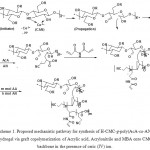 |
Scheme 1: Proposed mechanistic pathway for synthesis of H-CMC-g-poly(AcA-co-AN) hydrogel via graft copolymerization of Acrylic acid, Acrylonitrile and MBA onto CMC backbone in the presence of ceric (IV) ion. |
Scheme 1.
FTIR spectroscopy was used for identification of the hydrogel. Figure 1 shows the IR spectra of the CMC and the resulted hydrogel. The band observed at 1607 cm-1 , 1430 cm-1 and 1330 cm-1 be attributed to C=O stretching and bending in carboxylate(COO –) functional groups of substrate backbone (Figure 1a). The broad band at 2500-3500 cm-1 is due to stretching of –OH groups of the CMC. In the spectra of the hydrogel the characteristic bands at 1637 cm-1 , 1715 cm-1 and 2240 cm-1 were attributed to carboxyamide( MBA crosslinker) , carboxylic acid (AcA monomer) and cyanide groups (acrylonitrile monomers) stretching respectively.
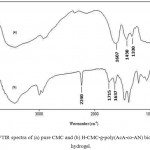 |
Figure 1: FTIR spectra of (a) pure CMC and (b) H-CMC-g-poly(AcA-co-AN) biosuperabsorbent hydrogel.
|
Figure 1.
To obtain additional evidence of grafting, a similar polymerization was conducted in the absence of the crosslinker. After extracting the homopolymers, PAcA or PAN and unreacted monomers using a cellophane membrane dialysis bag (D9402, Sigma–Aldrich), an appreciable amount of grafted CMC (84%) was observed. The graft copolymer spectrum was very similar to Figure 1b. Also according to preliminary measurements, the sol (soluble) content of the hydrogel networks was as little as 1.9 %. This fact practically proves that all AcA and AN are involved in the polymer network. So, the monomers percent in the network will be very similar to that of the initial feed of reaction.
Scanning electron microscopy
One of the most important properties that must be considered is hydrogel microstructure morphologies. Figure 2 shows the scanning electron microscope (SEM) photographs of the surface (Fig. 2A) and the cross-sectional area (Fig. 2B) of the biosuperabsorbent with interconnected pores and the free-homopolymers biosuperabsorbent with interconnected pores (Fig. 2C). These pictures verify that the synthesized polymer in this work have a porous structure, where the pores might be induced into the hydrogel by water evaporation resulting from reaction heat. It is supposed that these pores are the regions of water permeation and interaction sites of external stimuli with the hydrophilic groups of the graft copolymers. The cross-sectional view of hydrogels (Fig. 2B) also exhibited large, open, channel-like structure.
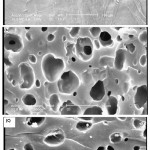 |
Figure 2: SEM photograph of CMC (a), free- homopolymers H-CMC-g-Poly(AcA-co-AN) biosuperabsorbent (b), and H-CMC-g-Poly(AcA-co-AN) biosuperabsorbent hydrogel (c).
|
Thermal analysis
Thermogravimetric analysis (TGA) was employed to thermally characterize the biosuperabsorbent hydrogel in comparison with the raw CMC (Figure 3). The thermal stability of the grafted CMC is improved as is obvious from the TGA curve. TGA of CMC (Figure 3-a) shows a weight loss in two distinct stages. The first stage ranges between 10 and 130 oC and shows about 17% loss in weight. This may correspond to the loss of adsorbed and bound water. No such inflexion was observed in the TGA curve of H-CMC-g-Poly(AcA-co-AN) hydrogel (Figure 3-c). This indicated that the grafted copolymers were resistant to moisture absorption. The second stage of weight loss starts at 230 oC and continues up to 300 oC during which there was 52% weight loss due to the degradation of CMC. In general, degradation of native CMC is faster than that of grafted CMC. About 60% weight loss takes place in the temperature range of 220-370oC for CMC. In the H-CMC-g-Poly(AcA-co-AN) biosuperabsorbent, a residual weight of 77% was observed at 310oC. The appearance of these stages indicates the structure of CMC backbones has been changed, which might be due to the grafting of polyacrylic acid acrylonitrile and chains. In general, the copolymer had lower weight loss than CMC. This means that the grafting of CMC increases the thermal stability of CMC in some extent13. We also studied the thermal stability of hydrogels in the presence and absence of Homopolymers. As observed from comparsion of Figures 3-b and 3-c, incorporation of Homopolymers to biosuperabsorbent (copolymers) structure increases the thermal stability of biosuperabsorbent.
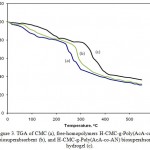 |
Figure 3: TGA of CMC (a), free-homopolymers H-CMC-g-Poly(AcA-co-AN) biosuperabsorbent (b), and H-CMC-g-Poly(AcA-co-AN) biosuperabsorbent hydrogel (c).
|
Figure 3.
Swelling kinetics
In practical applications, not only a higher swelling capacity is required, but also a higher swelling rate is needed. Buchholz has suggested that the swelling kinetics for the superabsorbents is significantly influenced by factors such as swelling capacity, size distribution of powder particles, specific size area and composition of polymer.20 Figure 3 represents the dynamic swelling behavior of the superabsorbent samples with various particle sizes in water. Initially, the rate of water uptake sharply increases and then begins to level off. The time required to reach the equilibrium swelling capacity was achieved after ~40 min. A power law behavior is obvious from Figure 3. The data may be well fitted with a Voigt-based equation (Eq. 2):21
St = Se (1- e –t/t) (2)
where St (g/g) is swelling at time t, Se is equilibrium swelling (power parameter, g/g); t is time (min) for swelling St, and t (min) stand for the “rate parameter”. The rate parameters for superabsorbent are found to be 0.57, 2.4, and 4.6 min for superabsorbents with particle sizes of 100-250, 250-400 and 400-550 μm, respectively. It is well-known that the swelling kinetics for the superabsorbent polymers is significantly influenced by particle size of the absorbents.21 With a lower the particle size, a higher rate of water uptake is observed. An increase in the rate of absorption would be expected from the increase in surface area with decreasing particle size of hydrogel.
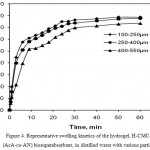 |
Figure 4: Representative swelling kinetics of the hydrogel, H-CMC-g-Poly(AcA-co-AN) biosuperabsorbent, in distilled water with various particle sizes.
|
Conclusion
A novel biosuperabsorbent hydrogel was prepared by simultaneously graft copolymerization of acrylic acid and acrylonitrile onto CMC in the presence of a crosslinking agent. The resultant superabsorbent had a large degree of water absorbency. Evidence of grafting was obtained by comparison of FTIR ,TGA and SEM spectra of initial substrates and biosuperabsorbent hydrogel. The study of FTIR spectra shows that in the hydrogel spectrum a new absorptions bands at 1715 cm-1 and 2240 cm-1 were appeared that attributed to the carboxylic acid and cyanide groups respectively. Overall, we report a crosslinking polymerization to achieve biosuperabsorbing hydrogel materials with lower cost. The biosuperabsorbent hydrogel will most probably posses higher biodegradability (due to the polysaccaride part) and higher swollen gel strength (due to the inorganic parts). The latter properties are of the subjects under consideration in our laboratory.
References
- Buchholz, F. L.; Graham, A. T. In Modern Superabsorbent Polymer Technology; New York: Wiley, (1997).
- Peppas, L. B.; Harland, R. S. In Absorbent Polymer Technology; Amsterdam: Elsevier, (1990).
- Loh, X. J.; Peh, P.; Liao, S.; Sng, C.; Li, J. J Control Release, 143, 175-182(2010).
- Liu, Y.; Chan-Park, M. Biomaterials, 30, 196-207(2009).
- Rasool, N.; Yasin, T.; Heng, J.; Akhter, Z. Polymer, 51, 1687-1693(2010).
- Tanuma, H.; Saito, T.; Nishikawa, K.; Dong, T.; Yazawa, K.; Inoue, Y. Carbohyd Polym, 80, 260-265(2010).
- Pourjavadi, A.; Harzandi, A. M.; Hosseinzadeh, H. Eur Polym J, 40, 1363-1371(2004).
- Tang, Q.; Lin, J.; Wu, J.; Zhang, C.; Hao, S. Carbohyd Polym, 67, 332-336(2007).
- Sugahara, Y.; Takahisa, O. J Appl Polym Sci, 82, 1437-1443(2001).
- Mi, P.; Ju, X.; Xie, R.; Wu, H.; Ma, J.; Chu, L. Polymer,51, 1648-1653(2010).
- George, M.; Abraham, T. E. Int J Pharma, 335, 123-129(2007).
- Sadeghi, M.; Hosseinzadeh, H. Turk J Chem, 32, 375-388(2008).
- Bajpai, A. K.; Giri, A. Carbohydr Polym,53, 271-278(2003).
- Mahdavinia, G. R.; Pourjavadi, A.; Hosseinzadeh, H.; Zohuriaan, M. J. Europ Polym J, 40, 1399-1407(2004).
- Fanta, G. F. In Polymeric Materials Encyclopedia. Salamone, J. C., editor. Florida: CRC Press, Boca Raton, vol.10. p. 7901, 8051(1996).
- Rathna, G.V.N.; Damodaran, S. J Appl Polym Sci, 85, 45-51(2002).
- Yan, H.; Saiani, A.; Gough, J. E.; Miller, A. F. Biomacromolecules, 7, 2776-2782(2006).
- Pourjavadi, A.; Kurdtabar, M.; Mahdavinia, G. R.; Hosseinzadeh, H. Polym Bull, 57, 813-824(2006).
- Sadeghi,M, Yarahmadi,M, Oriental Journal of Chemistry, vol.27, no.2, 453-460,(2011).
- Omidian, H.; Hashemi, S. A.; Sammes, P. G.; Meldrum, I. Polymer, 39, 6697-6704(1998).
- Omidian, H.; Hashemi, S. A.; Sammes, P. G.; Meldrum, I. Polymer, 40, 1753-1761(1999).

This work is licensed under a Creative Commons Attribution 4.0 International License.





